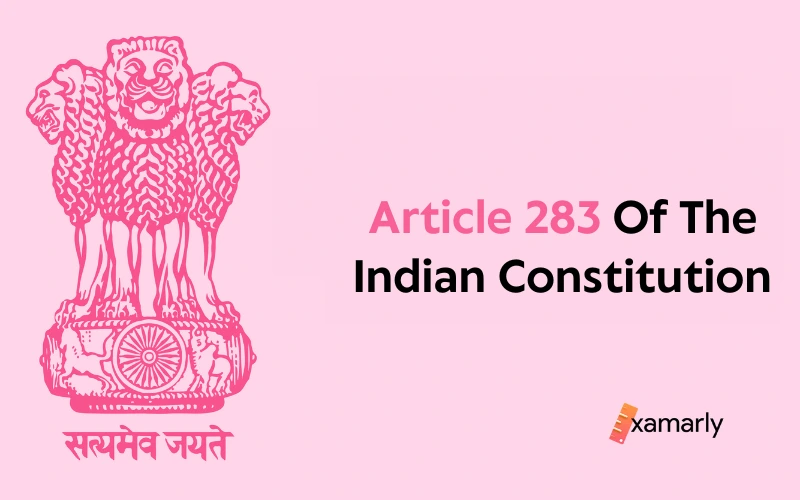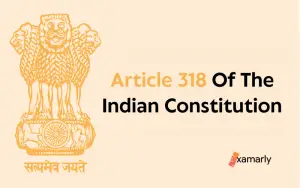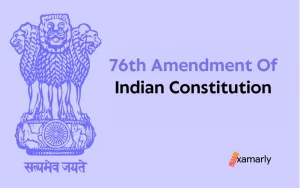An Overview
Article 283 of the Indian Constitution contains provisions for the custody, payment and withdrawal of funds such as the Consolidated Funds, Contingency Funds and the funds that are meant for the public accounts.
This article is included in Part XII of the Constitution of India. It is titled ‘Finance, Property, Contracts and Suits’. Under Part XII, the article is a part of Chapter I which is on ‘Finance’.
Read this detailed blog which focusses on Article 283 of the Indian Constitution, its clauses, its background in brief and a few other additional information.
- An Overview
- What Is Article 283 Of The Indian Constitution All About?
- Clause (1) Of Article 283 Of The Indian Constitution: Explained
- Clause (2) Of Article 283 Of The Indian Constitution: Explained
- Background Of Article 283 Of The Indian Constitution
- What Is Meant By Consolidated Fund Of India?
- What Do You Understand By Contingency Funds?
- Summing Up
- FAQs Related To Article 283 Of The Indian Constitution
- What Does Article 283 Of The Indian Constitution Deal With?
- What Is The Purpose Behind The Shaping Of Article 283 Of The Indian Constitution?
- Can The Government Withdraw Money From The Consolidated Fund of India Without The Approval Of Parliament?
- Is There Any Limit On The Amount Of Money That Can Be Withdrawn From The Consolidated Fund Of India?
- Can The Government Withdraw Money From The Consolidated Fund Of India For Any Purpose?
- How Many Clauses Are There In Article 283 Of The Indian Constitution?
- Which Other Article Of The Indian Constitution Falls Under The Category Of Miscellaneous Financial Provisions?
- Which Amendment Of The Indian Constitution Is Related To Article 283 Of The Indian Constitution?
- What Alteration Did The Constitution (Seventh Amendment) Act, 1956, Make To The Second Clause Of Article 283 Of The Indian Constitution?
What Is Article 283 Of The Indian Constitution All About?
The opening line of Article 283 of the Indian Constitution throws light on the scope of this article. It talks about the payment, withdrawal and the custody of the Consolidated Funds as well as the Contingency Funds. It also takes into account the funds that are credited to the account meant for the expenses in the interest of the public.
This article is composed of two clauses, namely- clause (1) and clause (2). Let us take a look at the two clauses of this article one at a time and analyse its contents closely. This will give us a clear picture behind the intention of Article 283 of the Indian Constitution.
Clause (1) Of Article 283 Of The Indian Constitution: Explained
(1) The custody of the Consolidated Fund of India and the Contingency Fund of India, the payment of moneys into such Funds, the withdrawal of moneys therefrom, the custody of public moneys other than those credited to such Funds received by or on behalf of the Government of India, their payment into the public account of India and the withdrawal of moneys from such account and all other matters connected with or ancillary to matters aforesaid shall be regulated by law made by Parliament, and, until provision in that behalf is so made, shall be regulated by rules made by the President.
The first clause of Article 283 informs us that the Indian Constitution deals with the management of government funds in India, specifically the Consolidated Fund of India and the Contingency Fund of India. It further states that Parliamentary legislation is responsible for regulating the custody of Consolidated Funds in terms of payment and withdrawal of money received from these funds.
The same applies to the custody of moneys received, payment of moneys, and withdrawal of other public moneys received by the government. It also states that until such a law is made by the Parliament, these matters will be regulated by rules made by the President of India.
In other words, the provision contained in this clause of the article establishes that the management of government funds in India is governed by laws and rules made by Parliament and the President of India, respectively. It specifies that the Consolidated Fund and the Contingency Fund must be properly managed and that all public moneys received by the government must be deposited into the appropriate accounts and accounted for in a transparent and accountable manner.
Clause (2) Of Article 283 Of The Indian Constitution: Explained
(2) The custody of the Consolidated Fund of a State and the Contingency Fund of a State, the payment of moneys into such Funds, the withdrawal of moneys therefrom, the custody of public moneys other than those credited to such Funds received by or on behalf of the Government of the State, their payment into the public account of the State and the withdrawal of moneys from such account and all other matters connected with or ancillary to matters aforesaid shall be regulated by law made by the Legislature of the State, and, until provision in that behalf is so made, shall be regulated by rules made by the Governor of the State.
The above-mentioned clause tells us that the management of government funds at the State level in India is under the purview of the Indian Constitution.
The clause further states that the custody, payment, and the withdrawal of funds from the Consolidated Fund and the Contingency Fund of a State, as well as the custody, payment, and withdrawing of other public funds received by the State government, must be regulated by law that has been made by the Legislature of a State.
In addition to that, it also states that until such a law is made, these matters will be regulated by rules made by the Governor of the State.
To put it in simple words, clause (2) of Article 283 establishes that the management of government funds at the State level in our country is governed by laws and rules made by the Legislature of a State and the Governor, respectively. The clause specifies that the Consolidated Fund and the Contingency Fund of a State must be properly managed. All public moneys received by the State government must be deposited into the appropriate public account belonging to the State.
A point to be noted here is that by the Constitution (Seventh Amendment) Act, 1956, the words “or Rajpramukh” were removed from this clause.
The second clause of Article 283 is quite similar to the provision held in the previous clause. The only difference is that this clause is with respect to the Consolidated Funds and the Contingency Fund of a State. The former clause talks with context to the entire nation while the latter talks specifically about the States.
Another difference is that under the provision provided by clause (1) of Article 283, the person of authority is the President of India while in case of the provision provided under clause (2) of this article the person of authority is the Governor of a State until a law in this respect is made by Parliament.
Background Of Article 283 Of The Indian Constitution
Having a good understanding of the provisions helps to get an in-depth knowledge of an article. However, learning about the background of an article helps in the long run. Here is a background of Article 283 of the Indian Constitution in brief.
- Draft Article 263 was introduced in the Constituent Assembly for the purpose of Article 283 of the Indian Constitution.
- This Draft Article was taken up for debate and discussion with the members of the Assembly.
- The first discussion was held on August 10, 1949. It was continued on September 9, 1949. The final discussion regarding Draft Article 263 was held on October 13, 1949.
- The Chairman of the Drafting Committee made a proposition on the initial day of discussion that was held. He opined that the words “Revenues of India” be changed to “Consolidated Fund” in the Draft Article. He also made other slight adjustments to the text.
- These changes were brought about in the Draft Article without much objection from the members of the Assembly.
- Some other alterations were done to Draft Article 263 in the subsequent discussions that took place regarding Draft Article 263. These amendments were approved and eventually it was adopted into the Constitution of India.
What Is Meant By Consolidated Fund Of India?
The Consolidated Fund of India is a fund maintained by the Government of India. It serves as a repository into which all government revenues are deposited. This could include taxes, duties, and other receipts. It is used to meet the government’s various expenditure commitments. This could be the salaries of government employees, pensions, and other social welfare schemes. However, it does not include some exceptional items.
The Consolidated Fund is also used to meet the government’s capital expenditure commitments. For instance, the infrastructure development. This government body is managed by the Ministry of Finance. It is governed by the Consolidated Fund of India Act, 1950.
What Do You Understand By Contingency Funds?
The Contingency Fund of India is a fund maintained by the Government of India. This fund is accumulated to meet unforeseen expenditure. It is managed by the Ministry of Finance. This fund is governed by the Contingency Fund of India Act, 1950.
The Contingency Fund is created to allow the government to make urgent and unforeseen expenditures without the need to seek prior approval from Parliament. Such expenditures may include natural disasters, security threats, or other emergency situations.
The government can draw from the Contingency Fund by issuing a notification in the Official Gazette. The amount withdrawn by the government must be reported to Parliament at the earliest opportunity. The Contingency Fund is replenished through the Consolidated Fund of India.
You Might Also Like:
| Article 392 Of The Indian Constitution | Article 282 Of The Indian Constitution |
| Article 395 Of The Indian Constitution | Article 394 Of The Indian Constitution |
Summing Up
After delving into the details of Article 283 of the Indian Constitution, we can come up with some conclusions. They have been listed below.
- The Indian Constitution outlines the rules and regulations related to the management of government funds in India. This includes the Consolidated Fund of India and the Contingency Fund of India.
- At the national level, the custody, payment, and withdrawal of these funds, as well as other public moneys received by the government, must be regulated by the President of India until a law is made by Parliament.
- At the state level, the management of government funds is governed by the governor of the State until laws and rules are made by the Legislature of a State.
- These laws and regulations guarantee that government funds are handled appropriately and accounted for in a way that is both open and accountable to the public.
FAQs Related To Article 283 Of The Indian Constitution
What Does Article 283 Of The Indian Constitution Deal With?
Article 283 of the Indian Constitution deals with the rules related to the withdrawal of money from the Consolidated Fund of India.
What Is The Purpose Behind The Shaping Of Article 283 Of The Indian Constitution?
The purpose of Article 283 of the Indian Constitution is to ensure that the government can only withdraw money from the Consolidated Fund of India. The withdrawal of this fund is for the purposes specified in the Constitution. This must be done in accordance with the procedures laid down in the Constitution.
Can The Government Withdraw Money From The Consolidated Fund of India Without The Approval Of Parliament?
No, the government cannot withdraw money from the Consolidated Fund of India without the approval of Parliament. According to Article 283 of the Indian Constitution, all withdrawals from the Consolidated Fund of India must be authorised by law. This means that the government must seek the approval of Parliament before withdrawing any money from the Consolidated Fund.
Is There Any Limit On The Amount Of Money That Can Be Withdrawn From The Consolidated Fund Of India?
Yes, there is a limit on the amount of money that can be withdrawn from the Consolidated Fund of India. According to Article 283 of the Indian Constitution, the total amount of money that can be withdrawn from the Consolidated Fund in a financial year cannot exceed the total amount of the budget estimates for that year.
Can The Government Withdraw Money From The Consolidated Fund Of India For Any Purpose?
No, the government can only withdraw money from the Consolidated Fund of India exclusively for the purposes specified in the Constitution. These purposes include the payment of debts and liabilities incurred by the government, the maintenance of the armed forces and other services, and the administration of justice.
How Many Clauses Are There In Article 283 Of The Indian Constitution?
Article 283 of the Indian Constitution is made up of two clauses, namely- clause (1) and clause (2).
Which Other Article Of The Indian Constitution Falls Under The Category Of Miscellaneous Financial Provisions?
Apart from Article 283 of the Indian Constitution, the other article that is listed under the section of Miscellaneous Financial Provisions is Article 282 of the Indian Constitution.
Which Amendment Of The Indian Constitution Is Related To Article 283 Of The Indian Constitution?
The constitutional amendment act that made an alteration in the second clause of Article 283 of the Indian Constitution was the Constitution (Seventh Amendment) Act, 1956.
What Alteration Did The Constitution (Seventh Amendment) Act, 1956, Make To The Second Clause Of Article 283 Of The Indian Constitution?
The Constitution (Seventh Amendment) Act, 1956, made a minor revision in the second clause of Article 283 of the Indian Constitution. It removed the words “or Rajpramukh” provision of the said clause.






